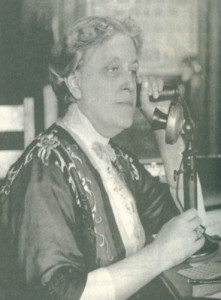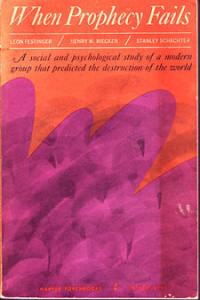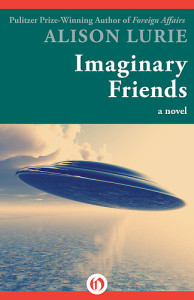 On Christmas Eve, 1954, nine people gathered in front of a modest home in Oak Park, Illinois, and tried rather piteously to sing Christmas carols in the street. This was by express request of benevolent beings from outer space, one of whom was actually Jesus, the birthday boy, though under another name. The group’s visible audience was not so festive: a crowd of around two hundred gawkers and mockers, unruly enough so that police had to be called in to control them. This was the final public appearance of the Seekers, a tiny UFO/mystical/apocalyptic cult in the last stages of having its core belief crushingly disconfirmed.
On Christmas Eve, 1954, nine people gathered in front of a modest home in Oak Park, Illinois, and tried rather piteously to sing Christmas carols in the street. This was by express request of benevolent beings from outer space, one of whom was actually Jesus, the birthday boy, though under another name. The group’s visible audience was not so festive: a crowd of around two hundred gawkers and mockers, unruly enough so that police had to be called in to control them. This was the final public appearance of the Seekers, a tiny UFO/mystical/apocalyptic cult in the last stages of having its core belief crushingly disconfirmed.

Their story is unusually well documented because, unknown to themselves, the Seekers were under powerful terrestrial scrutiny. Their prophetess, Dorothy Martin, a fiftyish housewife whose revelations came via automatic writing, had announced in August 1954 that global disaster on a scale unseen since the wrack of Atlantis was due to take place on December 21st, starting with great floods that would tear the heart out of America. She and the elect – that is to say, the Seekers and a few others – would be whisked away by flying saucers shortly before the calamity. This firmly dated and totally batty prophecy was just what certain scholars had been eagerly awaiting.
A trio of social psychologists at the University of Minnesota, headed by Leon Festinger, coiner of “cognitive dissonance,” had made certain predictions about how such a group would react under exactly such circumstances. Seeing a golden opportunity to test those predictions, the psychologists leapt into action in October 1954 with small teams of specially trained participant-observers: moles who would infiltrate the group and document its behaviour before, during, and after Mrs Martin’s prophecy came crashing down.
 The result was When Prophecy Fails (1956), a volume that deserves a place on every skeptic’s bookshelf for at least three reasons. First, it is a classic study, of both intrinsic and historical interest. Second, the behaviour it documents is by no means limited to nutty little UFO cults, and explains an awful lot about the evolution of ideologies. Third, it is a gripping tale, and often excruciatingly funny, though told with academic neutrality and a reasonably straight face.
The result was When Prophecy Fails (1956), a volume that deserves a place on every skeptic’s bookshelf for at least three reasons. First, it is a classic study, of both intrinsic and historical interest. Second, the behaviour it documents is by no means limited to nutty little UFO cults, and explains an awful lot about the evolution of ideologies. Third, it is a gripping tale, and often excruciatingly funny, though told with academic neutrality and a reasonably straight face.
The skeptic’s fiction shelf can also benefit from the legacy of the Seekers. The great Alison Lurie’s novel Imaginary Friends (1967) is obviously based on the Minnesota study, and makes a great companion volume to it. Narrated by the junior scholar on a very similar sociological project involving a tiny UFO/mystical/apocalyptic cult called the Truth Seekers, the storyline maps the shifting relationships among the cult members as the date of the prophesied catastrophe/UFO-rapture approaches – and passes.
It is not a straight retelling of the Seekers’ story, however, and the differences go beyond reworking a few details of the cult’s activities. While Festinger et al simply changed the names of real people and places in their factual account, Lurie puts characters of her own invention into the same social dynamic, and lets the scenario play out to a believable conclusion. The result is witty, hugely entertaining, and faithful to the spirit of the source material.
But Lurie’s most interesting spin is not on the main text of When Prophecy Fails, but on its methodological appendix. This is the bit where Festinger et al were very frank about the difficulties of being covert participant-observers – of trying to minimize, for example, the impact they had on the Seekers simply by joining up and going to meetings. (One crucial meeting consisted of five researchers and only ten genuine Seekers.) They also had to become vegetarian; they had to rip all the metal out of their clothing, from zippers to brassiere hooks; they had to stay awake through exhausting all-nighters, and then write up their observations. And though Festinger et al tactfully don’t say this, they almost certainly had to fight off some righteous fits of the giggles now and then. Lurie, however, takes full advantage of her hapless narrator to play out for us, not just the “observer effect,” but also the effect on the observers.
where Festinger et al were very frank about the difficulties of being covert participant-observers – of trying to minimize, for example, the impact they had on the Seekers simply by joining up and going to meetings. (One crucial meeting consisted of five researchers and only ten genuine Seekers.) They also had to become vegetarian; they had to rip all the metal out of their clothing, from zippers to brassiere hooks; they had to stay awake through exhausting all-nighters, and then write up their observations. And though Festinger et al tactfully don’t say this, they almost certainly had to fight off some righteous fits of the giggles now and then. Lurie, however, takes full advantage of her hapless narrator to play out for us, not just the “observer effect,” but also the effect on the observers.
When Prophecy Fails: A Social and Psychological Study of a Modern Group That Predicted the Destruction of the World, by Leon Festinger, Henry Riecken, and Stanley Schachter (1956)
Imaginary Friends, by Alison Lurie (1967)
